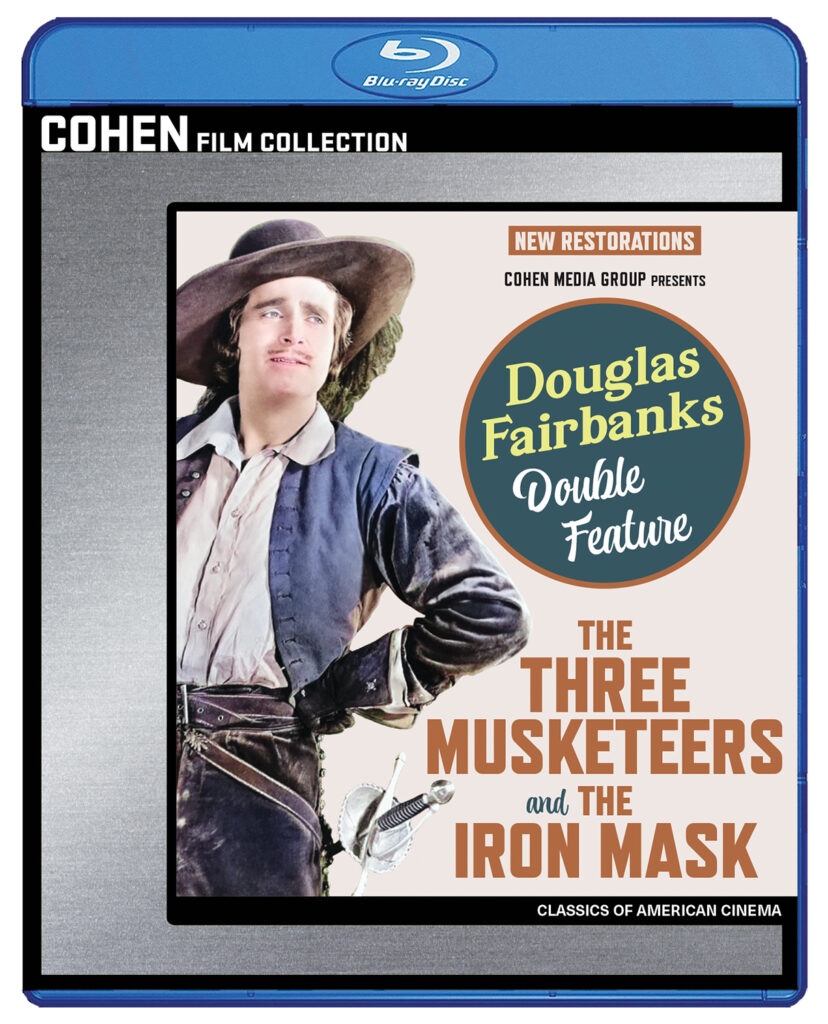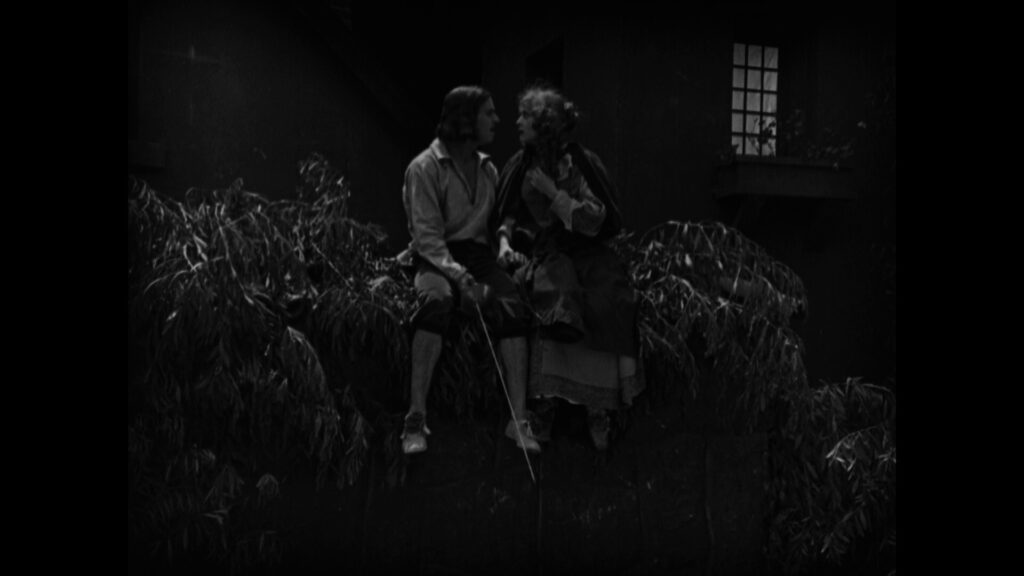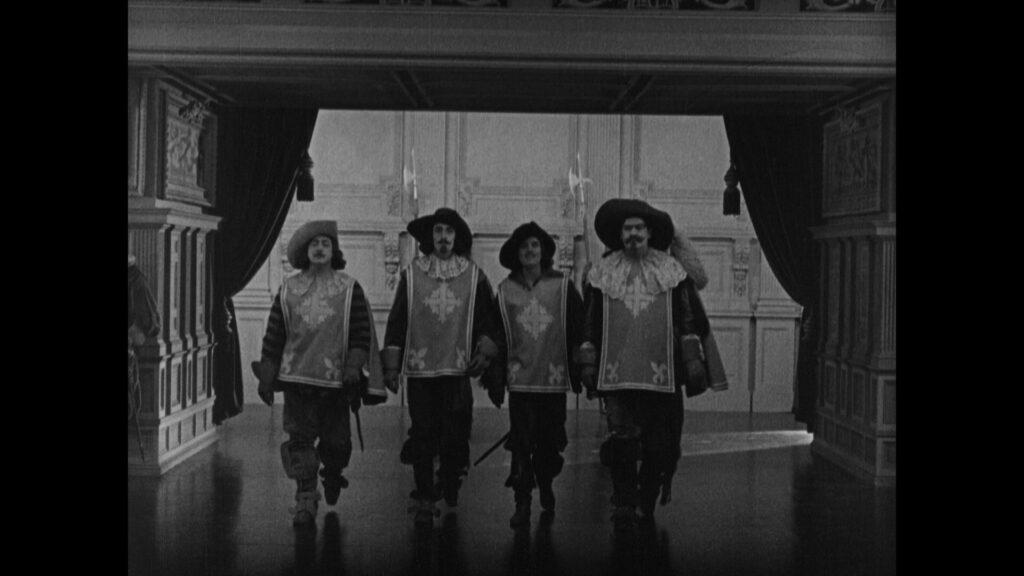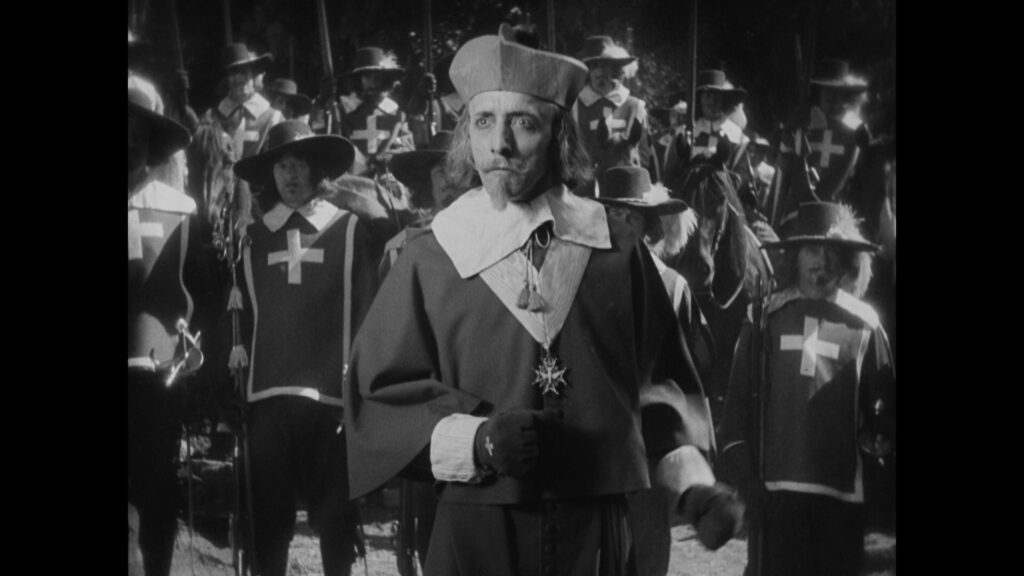Doug’s All-American Romps Through Historical France And Alexandre Dumas’ Classic Adventure Tales
DIRECTED BY FRED NIBLO (3M) & ALLAN DWAN (IM)
STREET DATE: OCTOBER 17TH, 2023/ COHEN MEDIA GROUP & KINO LORBER

The Cohen Film Collection, in collaboration with Kino Lorber, brings two recent restorations of Douglas Fairbanks‘ The Three Musketeers (1921) and its 1929 sequel The Iron Mask, based on the classic adventure tales by Alexandre Dumas, to home video this October on a double-feature Blu-ray disc.
With scores by Robert Israel on 3M and the late Carl Davis on IM, performed by the Moravian Philharmonic Orchestra and the City of Prague Philharmonic, respectively, both films are included without special features as such, excepting the most advantageous home video presentation of these silent swashbuckler spectacles to date. Utilizing the best source elements available for the first film, scanned and transferred in the highest resolution feasible at silent film-speed, and continuing a twenty-year physical restoration process began by Kevin Brownlow and Patrick Stanbury on Douglas Fairbanks’ own nitrate print of The Iron Mask, digitally restored by CFC, Photoplay Productions, and completed at Roundabout Entertainment, are again musically packaged with equally appropriate although different approaches to the restored source images.
Specifically for these presentations, the Israel score on the first film draws on era-specific Baroque instrumentation utilizing harpsichord, strings, and horns, while the Davis musical-setting for its sequel opens up to Romantic-like arrangements redolent of Beethoven and Brahms, lushly evoking the era of its mid-19th century composition by Dumas. (While another reviewer noted aural oddities in the solo instrumental recordings of another Cohen/KL Fairbanks double-feature release, this reviewer did not hear those problems here, possibly because the open-channel, louder, and fuller orchestra-settings lose little of their sonic complexity when compressed for a digital-track.) In all, the audio-visual journey of 90-100+-year-old films, from theater palaces of yesteryear to pristine viewing in one’s living room, is obviously as adventurous and involved as the swashbuckling careers of four of the French King’s Musketeers, spanning the reigns of Louis XIII and Louis XIV.
Leaving reviewers little to note then that the magnificence of the restored imagery and their musical settings clearly befit the lavish scale of the original productions. They do. But as for a more personal connection to these specific films, drawing readers into a more sustained analysis of their social and cultural importance, one might first note that this reviewer’s paternal grandfather, born in the early 19-teens, was an original fan of Douglas Fairbanks, and saw all of his earliest westerns through his contemporary set stunt-comedies to finally his historical adventure epics first-run. Indeed, such was their impression, which may have had no small influence on his fifty-year career in various aspects of physical education, that this reviewer personally witnessed their sequel, so to speak, when he once saw his then 76-year-old grandfather perform a backflip off a collapsing ladder: landing with a perfect Doug flourish of outstretched arms, crouched knees, and broad grin. (It was like somehow experiencing a Douglas Fairbanks moment in real life.)
And that personal connection extends to the life of the imagination, where if one had then known it, one’s reading and viewing habits from childhood on were almost always Doug-relevant. One John Davis, the older brother of this reviewer’s late mother, edited a film journal called The Velvet Light Trap and played guitar in the hilariously named White Trash Blues Band through his college and post-college years, later co-founding a Madison, Wisconsin-based comic book company called Capitol City Distribution in the late ’70s. Growing up in the early ’80s, the upshot of his incredibly varied background was a steady supply of comic books and video tapes whose choice was particularly formed by Uncle John’s abiding passion for and expertise in the 1930s and ’40s swashbucklers and historical adventure films of director Michael Curtiz and star Errol Flynn.
And how would those latter have existed – from Captain Blood (1935) through The Adventures of Robin Hood (1938) to The Sea Hawk (1940) – without the screen-trailblazing antics of Douglas Fairbanks? Obviously they would not have, and considering everything from pulp adventure stories to romantic and comic book male-heroism to action star-athleticism – on a screen-continuum from Fairbanks to Flynn; and on through Tyrone Power, Burt Lancaster, Louis Hayward, Cornel Wilde; and far-flung continuing through Jean-Paul Belmondo, Jackie Chan, and on up to Tom Cruise – one may begin to see that All-American Doug-influence just about everywhere.
Which to illustrate just before turning to more urgent reviewing matters, this reviewer experienced fairly recently in revisiting a comic book-title viewed as “off-limits” when the odd issue came his way as a kid. Writer-artist Howard Chaykin’s dystopian vision of a corporate-owned, entertainment-overloaded, hyper-violent, drug-fueled 2031 America in his groundbreaking American Flagg! series (1983-87) may have looked unusually bleak and scary to a much too young 9 or 10-year-old, but read again in midlife, one could almost hear the can-do spirit (if not exactly the, um, precisely-worded sentiments) of Douglas Fairbanks himself echoed in the ultimately optimistic and equally swashbuckling words of Mars-born Plexus Ranger Reuben Flagg:
…The damage is deeper than physical disrepair–much deeper. The American Spirit–the honest, openhearted driving force of solidarity–has been castrated. Betrayed… by slimy fat cats who use patriotism like a tart uses cheap perfume… Someone’s got to stop the decline… or try. The U.S.A.’s gonna be 300 years old in ’76. I’d like to do my bit to make it a happier birthday.
With Martian Flagg and his Plexus Rangers on a continuum with Doug’s rogue Gasconian musketeer D’Artagnan, the historical France of 1620 to 1658, as written by Alexandre Dumas between 1840 and 1850, and screen-visualized in both 1921 and 1929, the 150th birthday of the USA smack-dab in-between, returns us to an unusually timely home viewing-context as we rapidly approach its 250th birthday 100 years later. France of old merging into the America of silent screen-yesteryear, and into wherever or whatever we are today, it’s all in the end the same high adventure, with Douglas Fairbanks, his forebears, and descendants riding to the rescue once again.
THE THREE MUSKETEERS (1921)
DIRECTED BY FRED NIBLO

The film opens with court intrigue between King Louis XIII (Adolphe Menjou) and his queen, Anne of Austria (Mary McLaren). An international episode arising between Queen Anne and England’s Duke of Buckingham (Thomas Holding), while far from a state secret, nevertheless threatens the security of the nation and its delicate balance of power, with the love-besotted queen enlisting her seamstress Constance Bonacieux (Marguerite De La Motte) as go-between in helping to conceal the affair while also keeping a line of romantic communication open with the persistent English aristocrat. France’s religious head of state, the fearsome Cardinal Richelieu (Nigel De Brulier), with his equally feared lieutenants Father Joseph (Lon Poff) and the Count De Rochefort (Floyd Irwin), takes advantage of this crisis to weaken the king’s power and the queen’s influence while consolidating his own, under the guise of preserving an uneasy status quo.
Into this potentially explosive situation strolls, or more accurately rides, leaps, bounds, scales, swordplays, and generally bluffs and blusters a hotheaded young adventurer from the remote region of Gascon named D’Artagnan (Fairbanks). Whose ambition to become a King’s Musketeer is immediately thwarted in quick succession by first brawling with the Cardinal’s guards, then challenging the best musketeers Athos, Porthos, and Aramis (Léon Barry, George Siegmann, Eugene Pallette) to duels, and finally romancing Constance at her father’s beautifully ramshackle inn. Ultimately building to a sustained sequence involving an otherwise meaningless diamond brooch, a gift from the king to the queen regifted by the queen to the Duke of Buckingham, the brooch’s restoration is threatened by the Cardinal’s sinister agent provocateur Milady de Winter (Barbara La Marr). But if D’Artagnan and his musketeer friends can retrieve the contested jewelry before a climactic royal procession commences, saving the king from knowledge of his cuckolding may finally assure D’Artagnan’s appointment to the musketeers, a significant feather-in-the-cap for his friends, and the severe embarrassment of the powerful and influential Cardinal.

Having read the book and seen many TV and movie adaptation of Dumas’ 1844 serial-novel, of which Richard Lester’s two-part, all-star 1973-74 film remains the best known, the biggest surprise to first-time viewers familiar with the source material and its filmings may be that Douglas Fairbanks is kept offscreen for the film’s initial two reels, the film instead plunging us into the royal scandal described above, and, in this, how surprisingly faithful the slow-setting of the plot and characters is to the source material. Yet unlike subsequent adaptations, Fairbanks’ D’Artagnan is the whole show here, the cast of hundreds and the film’s magnificent set-design easily overshadowed by the actor’s emphatic presence. Dynamic even when striking a static pose, head thrust back, chest bursting forward, with the hilt of his ever-ready sword balanced downward against his palm, the saber instantly flips to his solid grip and a solid reel’s worth of mind-boggling acrobatics commence. When Doug gets going, leaping on a horse’s back at twenty paces, say, try in vain at 21-frames-per-second to ever find the precise image where Fairbanks’ physicality switches from rest to action.
Only his second swashbuckler, following The Mark of Zorro (1920), the derring-do personality of his previous contemporary-set comedies and scenic western adventures remains entirely intact, and despite the film’s strong attention to historical detail in its costume and art direction, Doug the irrepressibly All-American Guy unavoidably personifies the boundlessly optimistic spirit of the 1920s. In this, D’Artagnan’s flip-stabbing of a Cardinal’s guard, for one, planting a dagger precisely center of the cross above the guard’s heart as he effortlessly sails upside-down and over, once seen, will never be forgotten, and seems to encapsulate the era of its making in a mere few hundred feet of film. But such is the sheer force of his personality, and the corresponding force by which this film in its best action sequences is realized, that he never seems an anachronism, even within a world and its finery he clearly predates in both manner and personality by just over 300 years. In 136 minutes and 13 reels, The Three Musketeers leaves little doubt that royalist France was not somehow saved by a singularly brash American.
THE IRON MASK (1929)
DIRECTED BY ALLAN DWAN

Picking up where the last film left off, Louis XIII (Ralph Sedan) and Anne of Austria (Belle Bennett) have reconciled insofar as to conceive a child, but the happy birth of a son and heir quickly concerns the aging and ailing Cardinal Richelieu (Nigel De Brulier) when the arrival of a second and identical baby boy again threatens the security of the state and France’s delicate balance of hereditary power. Richelieu entrusts the mission of concealing the twin to his aristocratic henchman Count De Rochefort (Ulrich Haupt), and the silencing of the Queen’s midwife, D’Artagnan’s lady-fair Constance Bonacieux (Marguerite De La Motte), to the wily Milady de Winter (Dorothy Revier). Now Chief Musketeer D’Artagnan (Fairbanks), with his three steadfast confederates Athos, Porthos, and Aramis (Lèon Barry, Stanley J. “Tiny” Sandford, Gino Corrado), gives pursuit to the Cardinal’s sinister agents, during which Milady tragically succeeds in killing Constance, and in which De Rochefort initially fails in bringing the twin child to safety. First banishing De Rochefort for his failure, the declining Cardinal turns his stern attention to the musketeers, decreeing that the friends in eternity must never again meet on this earth.
Fifteen years later, D’Artagnan, long separated from his friends, is now the trusted advisor and protector of young Louis XIV (William Bakewell), who is soon embroiled in a plot involving the long-absent, returning, and vengeance-seeking De Rochefort. Unbeknownst to the French court, or the surviving Queen Mother, Anne of Austria, De Rochefort had some years before kidnapped the royal twin (also William Bakewell), and has transformed the physical double of Louis XIV into a malign and malicious, power-seeking madman. The undoubtedly familiar plot of substituting the evil twin for the good king rapidly ensues, the latter’s identity sealed behind the terrifying title-device while imprisoned in a ruinous castle on a rocky cliff overlooking a raging sea. Until D’Artagnan, with the lucky aid of an observant fisherman (Francis McDonald), discovers the truth and mounts a daring rescue mission of the impregnable prison by once more calling on his merry band of musketeers from the three distant corners of France. In again saving the country, however, their brief reunion may not long survive the dangerous raid, but D’Artagnan, Athos, Porthos, and Aramis – “All For One, and One For All” again ringing through their escapades – may yet be reunited in the Great Heroic Hereafter.

Doug’s valedictory silent swashbuckler spectacle is bookended by two sound-synchronized addresses in staged tableau, where Fairbanks as D’Artagnan, initially with his musketeer friends and penultimately alone, directly addresses his audience for the first time. Contrary to reputation, and despite the poor quality of the early sound-era’s recording-devices, Doug’s voice rings as true and clear as his character, and remains a resonantly fine summing-up, or screen-summation even, of his historical adventure roles. In that spirit, again, The Iron Mask leans heavily on its legacy, especially as a sequel to the earlier Dumas classic, that distills and conflates plot and character elements from D’Artagnan’s later adventures, notably The Man in the Iron Mask section of The Vicomte of Bragelonne: Ten Years Later (1847-1850). And while not a direct adaptation, more loosely based than anything, the considerably simplified storyline is appropriate to the Fairbanks approach to Dumas’ historical fiction.
Slightly less stuntwork on this go-round but considerably more spectacle, the sets and staging, which literally build upon director Allan Dwan’s previous work with Fairbanks on Robin Hood (1922), with perhaps a significant assist from here uncredited Thief of Baghdad (1924) designer William Cameron Menzies, rivals the scale of almost any large-scale silent production before it. While foremost a farewell to the genre, The Iron Mask can be equally viewed as its culmination.
One should note a curious lack of conventional screen romance in this last adventure, however. With the notable and memorable exception of Doug pulling himself up to a sustained lip-lock with his fair Constance leaning over a balcony in flashback, this also includes a hilariously weird sequence from the same sequence where all four musketeers spring to answer a midnight alarm from a cozily-shared four-poster bed. (The famed legend written over its canopy, in French, of All For One and One For All announcing its import with the literal opposite of subtext.) Despite the paucity of conventional romance in an otherwise conventional romantic tale, and its veneration of Brotherly Love aside, these unresolved strains nevertheless pay off to magnificent screen effect in a heavenly epilogue that will remain here unspoiled.
As a significant postscript, Kevin Brownlow and David Gill used this sequence to equally magnificent effect as essentially the promise of silent movie adventures “delivered”, as it were, for their seminal 1980 documentary on the American silent film, Hollywood. And as a fitting epilogue to the silent film-form itself, Doug certainly delivers a fine end to his leaping, bounding, boisterous, irrepressible self-creation.
…
“Castrated”, to return to a word that may have been puzzling when quoted earlier, from Howard Chaykin’s much-later swashbuckling comic book-saga American Flagg!, is germane to a continuing consideration of these male-centric adventure tales, particularly in the context of Chaykin applying that term to “the American Spirit”. A visual-verbal satirist with as close an eye for words as for pictorial detail, Chaykin is no doubt aware of the criticism levied against boys with their toys, and whether it be Top Gun (1986), John Wick (2014), Dirty Harry (1971), Conan the Barbarian (1982), Indiana Jones (1981-2023), or James Bond, 007 (1962-2021,?), and despite the type, era, or scale of ordnance these masculine action-heroes of a thousand faces may be packing, there remains a correspondingly reductive Freudian doubt, for all their massive displays of firepower and aggression, over the true strength of the steel that may or may not be in their scabbards.
Such arguments, however, tend to fall away, recede into the middle distance, as it were, when watching a truly spirited performer like Douglas Fairbanks, whose grace and energy onscreen displays a literally disarming joie de vivre. 100 years after these films first appeared, whose take-charge and can-do spirit may have been subsequently co-opted by opportunistic American politicians progressively mutating from Goldwater to Reagan to Trump, the “castrated American Spirit” Chaykin waggishly references is in a very real sense adequately compensated for, and any negative associations quickly forgotten, each time Doug joyously draws his sword.
Self-preservation, upholding the common good, defending the innocent, whathaveyou, fuggedaboudit: the boy’s world Douglas Fairbanks effortlessly conjures in Old California, Sherwood Forest, the thousandth and first Arabian Night, on the roiling, wine dark, high seas, or out in the brawling cobblestone streets of Louisian France, may have never in fact existed as more adventurously presented here, but their strength of spirit somehow lives on when watching these films. Cohen Film Collection and Kino Lorber on this double-feature Blu-ray allows us to once again experience a lost world of high action, incredible daring, flashing steel, and lusty men and women that will always live again whenever you hit “play”.
Images are credited to DVDBeaver and are directly captured from Cohen Media Group and Kino Lorber’s Blu-ray.

